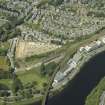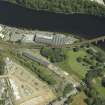Aberdeen, Ferryhill, Motive Power Depot
Engine Shed (19th Century)
Site Name Aberdeen, Ferryhill, Motive Power Depot
Classification Engine Shed (19th Century)
Alternative Name(s) Ferryhill Engine Shed; 61b; Aberdeen, Caledonian Railway Engine Shed
Canmore ID 147157
Site Number NJ90SW 71
NGR NJ 9402 0448
NGR Description Centred NJ 9402 0448
Datum OSGB36 - NGR
Permalink http://canmore.org.uk/site/147157
- Council Aberdeen, City Of
- Parish Aberdeen
- Former Region Grampian
- Former District City Of Aberdeen
- Former County Aberdeenshire
NJ90SW 71.00 centred 9402 0454
NJ90SW 71.01 NJ 94056 04484 Turntable
NJ90SW 71.02 NJ 94137 04595 Store (former engine shed)
Not to be confused with former Great North of Scotland Railway engine shed at Kittybrewster(centred NJ 9311 0786), for which see NJ90NW 1097.01.
Engine Shed [NAT]
OS 1:1250 map, 1976.
Ferryhill was the location of Aberdeen's first engine shed, situated within the 'V' of the junction between the Aberdeen and Deeside Rlys. The 1850 engine shed was a modest affair capable of housing two engines under cover and another two partly sheltered from the elements. It was situated on the W side of the main line close to the River Dee. A 20ft [6.1m] diameter turntable (originally intended for Montrose) was installed until a much larger and more permanent one could be acquired. By 1851, the shed was being used by engines of the Aberdeen Rly, the Scottish Central Rly, and the Scottish Midland Junction Rly, who were operating a locomotive pool. Some enlargement of the facilities must have taken place, although it is unclear when. It is most likely that the Caledonian Rly decided to redevelop the facilities in the late 1860's; the main shed building measured 166 by 38ft [50.6 by 11.6m] while the original turntable was replaced by one of 40ft [12.2m]. The North British Rly began to stable its locomotives at Ferryhill after they acquired running powers over Caledonian Rly metals from Montrose, but the resulting problems regarding payment soured relations between the two companies, particularly as the North British Rly never considered the construction of their own shed.
The Ferryhill shed was enlarged following the appointment of Dugald Drummond as Locomotive Superintendent of the Caledonian Rly in 1882, and in response to both his construction of larger engines and the increasing fish traffic at the period. The shed building was lengthened at the back to a length of some 230ft [70.1m], while a workshop for the fitters and a modern 50ft [15.2m] diameter turntable were installed.
The shed was further comprehensively redeveloped in 1907/8, when a building measuring some 214ft [65.2m] long by 188ft [57.3] and largely of brick was constructed; there were offices and stores. Included in the contract were a coaling shed, a sand-drying kindling furnace, and the locomotive foreman's house. This building opened in July 1908. The two South roads served a purpose-built repair and machine shop, while the covered manual coal stage and the 70ft [21.3m] Ransome and Rapier turntable were placed on the S side of the main shed, and a sand furnace near the entrance to the repair shop. The water tower formed part of the main building, n the NE side of the coal stage, and the old shed building was converted into a wagon repair shop. Disagreement between the North British Rly and the Caledonian Rly over the use of the facilities continued, the former company being prohibited from using the coaling stage so as not to impede the locomotives of the latter. This shed formed a capacious facility, being one of the few Caledonian Rly shed capable of housing its entire allocation under cover.
In 1924 the transfer of servicing to the former GNoSR shed (NJ90NW 1097.01) at Kittybrewster was considered, but this proposal foundered on account of the restricted track occupancy between Aberdeen and Kittybrewster. By the mid-1930's the LNER stationed about thirty locomotives at Kittybrewster, several of them of the largest size. The March 1953 allocation stood at forty locomotives. In 1953, a wheel-drop was installed at the shed to eliminate the need to use a breakdown crane for lifting, or to send locomotives to Perth or Dundee. The first diesel locomotives arrived in 1958, displacing steam locomotives used for shunting. Main-line diesel locomotives soon followed, and complete dieselisation was achieved in 1966. Ferryhill then became a diesel depot and later a signing-on point, but closed on 26 December 1987. The site is being redeveloped for housing, but the turntable (NJ90SW 71.01) and the 1860's shed (NJ90SW 71.02) remain in place.
[Locomotive allocations described: numerous illustrations include plans as at c. 1870 and c. 1950].
A Mackenzie 2007.












